一、RestClient操作索引库
1.1、RestClient是什么?
前面我们已经了解了如何利用 DSL 语句去操作 es 的索引库和文档,但作为 java 程序员,将来肯定是要通过 java 代码去操作 es 的,那么想要实现这些,就需要通过 es 官方提供的 RestClient 实现.
RestClient 实际上就是 es 官方提供的各种语言的客户端,他的作用就是帮助我们组装 DSL 语句,然后发送 http 请求给 es 服务器,而我们只需要通过 java 代码将请求发送给客户端,然后客户端就会帮我们来处理剩下的这些事情.
官方文档地址:Elasticsearch Clients | Elastic
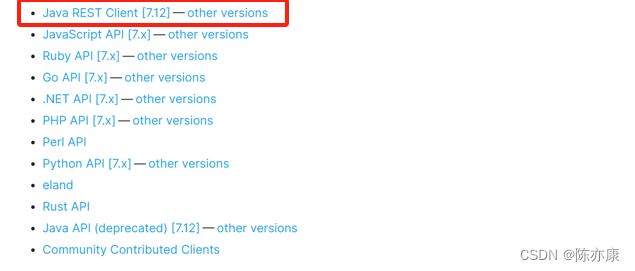
1.2、JavaRestClient 实现创建、删除索引库
1.2.1、前言
这里我将以一个 酒店 demo 工程来演示 JavaRestClient 的操作.
具体来讲,这是一个酒店的数据,创建的 sql 如下:
CREATE TABLE `tb_hotel` (
`id` bigint(20) NOT NULL COMMENT '酒店id',
`name` varchar(255) NOT NULL COMMENT '酒店名称;例:7天酒店',
`address` varchar(255) NOT NULL COMMENT '酒店地址;例:航头路',
`price` int(10) NOT NULL COMMENT '酒店价格;例:329',
`score` int(2) NOT NULL COMMENT '酒店评分;例:45,就是4.5分',
`brand` varchar(32) NOT NULL COMMENT '酒店品牌;例:如家',
`city` varchar(32) NOT NULL COMMENT '所在城市;例:上海',
`star_name` varchar(16) DEFAULT NULL COMMENT '酒店星级,从低到高分别是:1星到5星,1钻到5钻',
`business` varchar(255) DEFAULT NULL COMMENT '商圈;例:虹桥',
`latitude` varchar(32) NOT NULL COMMENT '纬度;例:31.2497',
`longitude` varchar(32) NOT NULL COMMENT '经度;例:120.3925',
`pic` varchar(255) DEFAULT NULL COMMENT '酒店图片;例:/img/1.jpg',
PRIMARY KEY (`id`)
) ENGINE=InnoDB DEFAULT CHARSET=utf8mb4;
之后我们创建 索引库 的时候,就需要基于上述 sql 数据,来考虑 mapping 约束.
1.2.1、初始化 JavaRestClient
a)引入 es 的 RestHighLevelClient 依赖
<dependency>
<groupId>org.elasticsearch.client</groupId>
<artifactId>elasticsearch-rest-high-level-client</artifactId>
</dependency>
b)由于 SpringBoot 默认的 ES 版本是 7.6.2,因此这里我们需要覆盖默认的 ES 版本.
在 yml 配置文件中添加如下版本信息即可.
<properties>
<java.version>1.8</java.version>
<elasticsearch.version>7.12.1</elasticsearch.version>
</properties>
c)初始化 RestHighLevelClient.
这里我们创建一个测试类 HotelIndexTest ,用来演示 RestClient 操作的相关方法.
@SpringBootTest
class HotelIndexTest {
private RestHighLevelClient client;
@BeforeEach
public void setUp() {
client = new RestHighLevelClient(RestClient.builder(
HttpHost.create
//将来如果是集群,这里还可以通过 HttpHost.create 继续连接多个节点
));
}
@AfterEach
public void tearDown() throws IOException {
client.close();
}
}1.2.2、创建索引库
这里就需要根据前面提供的表结构来考虑 mapping 该如何建立.
具体的要考虑:字段名、数据类型、是否参与搜索、是否分词、如果分词,分词器是什么?
这里可以先使用 Kibana 来编写.
PUT /hotel
{
"mappings": {
"properties": {
"id": {
// id 按照数据库那边的定义,这里因该类型设置为 long
// 但是这里比较特殊,在索引库中 id 比较特殊,将来都是字符串类型.
// 又因为 id 将来不做分词处理,因此是 keyword 类型
// id 将来肯定要参与 crud ,因此 index 就默认为 true 即可.
"type": "keyword"
},
"name": {
// 酒店的名字需要搜索和分词.
"type": "text",
"analyzer": "ik_max_word", "copy_to": "all"
},
"address": {
// 有时候我们需要根据地址来查询附近的酒店,分词也是有必要的("例如 徐汇龙华西路315弄58号")
"type": "text",
"analyzer": "ik_max_word",
"copy_to": "all"
},
"price": {
//将来要根据价格范围过滤酒店,所以需要搜索,分词就没必要了.
"type": "integer"
},
"score": {
//这里就和 price 一样了
"type": "integer"
},
"brand": {
//酒店的品牌肯定是不需要分词了,但一定需要参与搜索.
"type": "keyword",
"copy_to": "all"
},
"city": {
//城市名字不要分词,但需要参与搜索
"type": "keyword",
"copy_to": "all"
},
"star_name": {
//一星、二星、三星... 分词是没有意义的,组合起来才有意义.
//有的人就想住5星酒店,那肯定要参与搜索.
"type": "keyword"
},
"business": {
//商圈比如: 虹桥、外滩... 这些肯定不需要分词,但一定需要参与搜索.
"type": "keyword",
"copy_to": "all"
},
"pic": {
//图片这里就是一个 url 路径,不需要分词,也没有人会搜这个 url
//因此就这个 url 就可以当作关键字来处理.
"type": "keyword",
"index": false
},
"location": {
//在 es 中有两种特殊的方式,专门来表示地理坐标
//"geo_point": 表示地图上的点
//"geo_shape": 表示地图上的区域,也就是多个点组成.
//那么酒店肯定是属于一个点(毕竟从地球上看,再大的酒店也不过是点)
// geo_point 里面由 经度 和 纬度 组成,并且是这两拼在一起组成的字符串
"type": "geo_point"
},
"all": {
// 将来 name、address、brand... 这些字段大概率都需要参与搜索
// 也就意味着用户输入的的关键字,我们后端都需要根据多个字来搜.
// 并且我们可以想象以下 es 作搜索的时候, 根据多个字段去搜索的效率肯定是要比一个字段搜索效率要低
//这里对比以下数据库就清楚了.
//最重要的是, 我们也希望用户输入名称就能搜到相关的内容, 用户输入品牌也能搜到相关内容...
// es 就中有一个字段 "copy_to", 就是将当前字段的值拷贝到指定字段.
//这里我们就将需要搜索的字段都拷贝到 all 这个字段中就 ok
//这也就实现了在一个字段里, 搜索到多个字段的内容.
"type": "text",
"analyzer": "ik_max_word"
}
}
}
}自定义 all 字段的解读:
将来 name、address、brand... 这些字段大概率都需要参与搜索,也就意味着用户输入的的关键字,我们后端都需要根据多个字来搜,并且我们可以想象以下 es 作搜索的时候, 根据多个字段去搜索的效率肯定是要比一个字段搜索效率要低,这里对比以下数据库就清楚了~
最重要的是, 我们也希望用户输入名称就能搜到相关的内容, 用户输入品牌也能搜到相关内容... es 就中有一个字段 "copy_to", 就是将当前字段的值拷贝到指定字段。这里我们就将需要搜索的字段都拷贝到 all 这个字段中就 ok ,实现了在一个字段里, 搜索到多个字段的内容.
而且这里还做了优化,并不是真的吧文档拷贝进去,而是创建索引,将来你去查的时候,是看不到这些字段,但搜却能搜到(类似于根据指针找到数据所在位置).
copy_to 用法如下:
- 拷贝到单个字段中:"copy_to": "all" (拷贝到 all 字段中)
- 拷贝到多个字段中:"copy_to": ["all", "suggestion"] (拷贝到 all 和 suggestion 字段中)
创建索引库代码如下:
@Test
public void testCreateHotelIndex() throws IOException {
//1.创建 Request 对象
CreateIndexRequest request = new CreateIndexRequest("hotel");
//2.编写请求参数(MAPPING_TEMPLATE 是一个静态常量,内容是创建索引库的 DSL 语句)
request.source(MAPPING_TEMPLATE, XContentType.JSON);
//3.发起请求
client.indices().create(request, RequestOptions.DEFAULT);
}
- CreateIndexRequest 的构造参数就是请求创建的索引库的名字.
- MAPPING_TEMPLATE:是自定义的静态常量,内容是创建索引库的 DSL 语句.
- client.indices(): 这个方法的返回值是一个对象(indices 是 index 的复数形式),包含了操作索引库的所有方法.
- RequestOptions.DEFAULT :就表示走默认的方法.
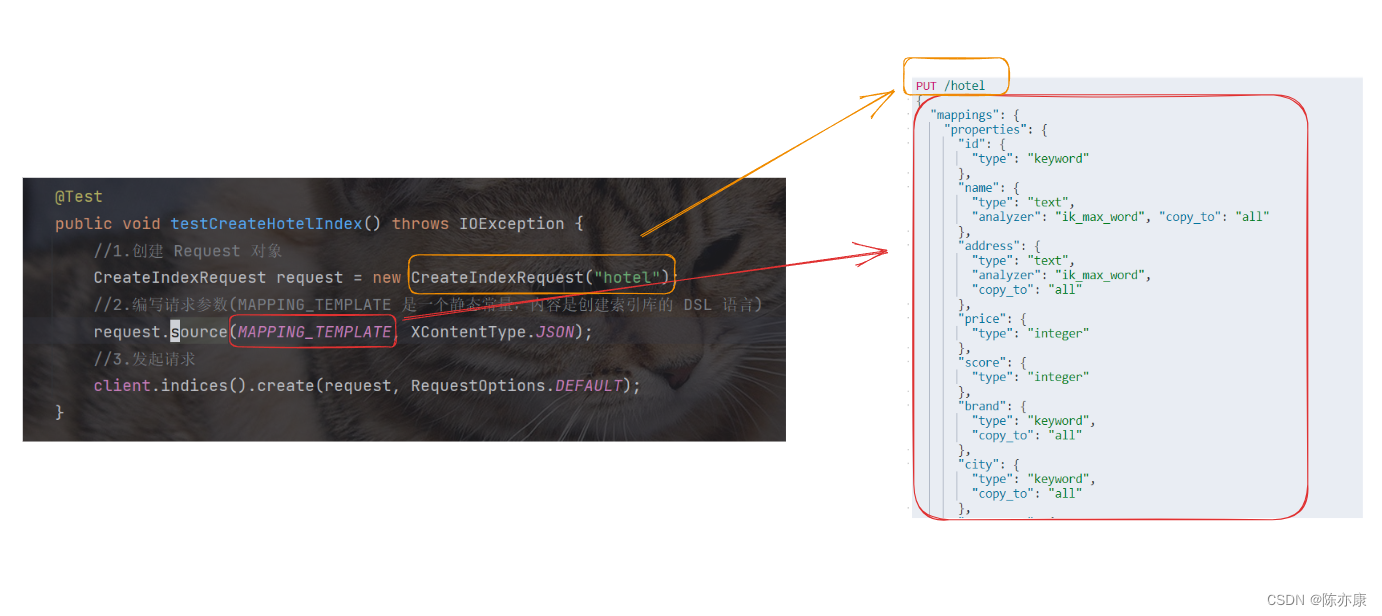
执行以后发现运行成功了~

之后去 Elastic DevTools 上去 GET,就可以看到新增的索引库了~
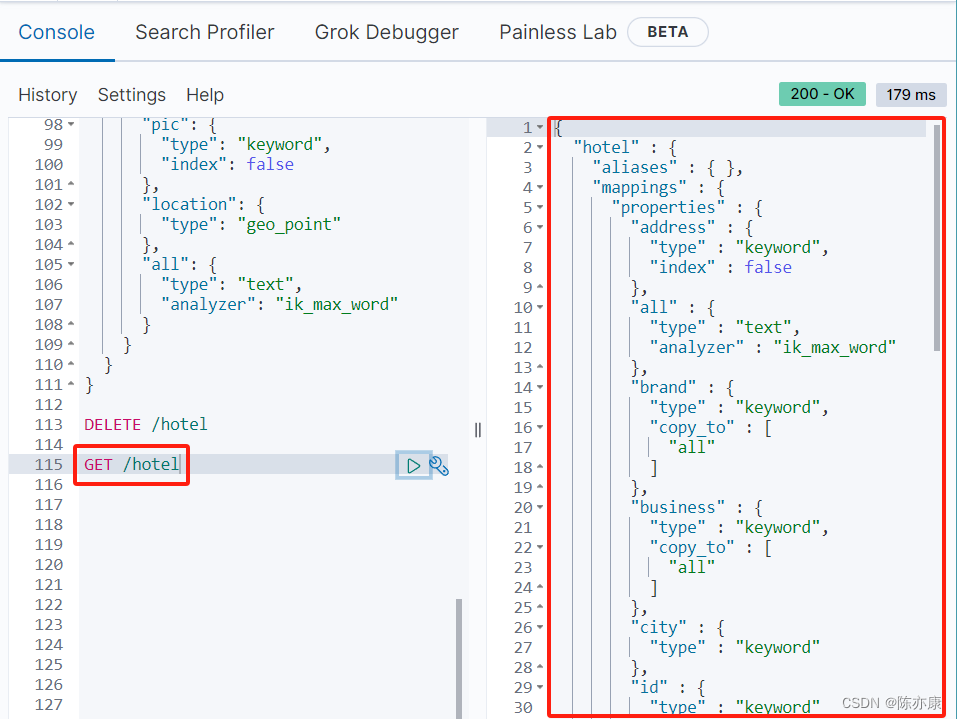
1.2.3、判断索引库是否存在
判断索引库是否存在代码如下:
@Test
public void testExistsHotelIndex() throws IOException {
//1.创建 Request 对象
GetIndexRequest request = new GetIndexRequest("hotel");
//2.发送请求
boolean exists = client.indices().exists(request, RequestOptions.DEFAULT);
System.out.println(exists);
}
很多时候,我们先写 client.indices().exists 就可以之间看出需要什么参数
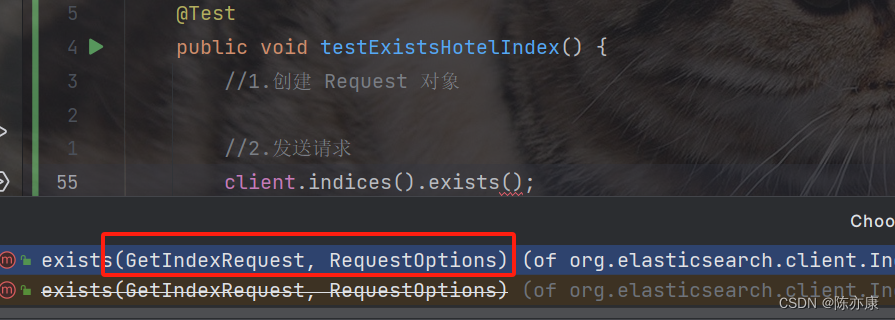
运行以后,可以看到通过了(true 是因为上个案例添加索引库是存在的).

1.2.4、删除索引库
判断删除索引库代码如下:
@Test
public void testDeleteHotelIndex() throws IOException {
//1.创建 Request 对象
DeleteIndexRequest request = new DeleteIndexRequest("hotel");
//2.发送请求
client.indices().delete(request, RequestOptions.DEFAULT);
}

之后再查询就发现查询不到了,表明删除成功.
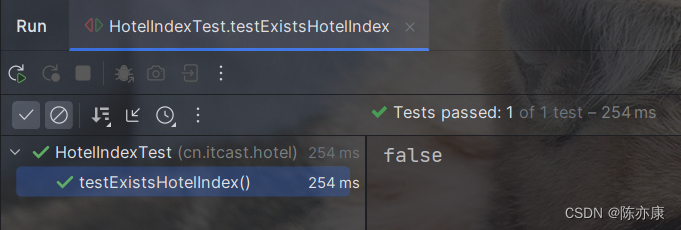
1.3、JavaRestClient 实现文档的 CRUD
1.3.1、初始化 JavaRestClient
这里的初始化操作和操作索引库的初始化一样(本质上都是连接 JavaRestClient 客户端).
@SpringBootTest
class HotelDocumentTest {
private RestHighLevelClient client;
@BeforeEach
public void setUp() {
client = new RestHighLevelClient(RestClient.builder(
HttpHost.create
));
}
@AfterEach
public void tearDown() throws IOException {
client.close();
}
}1.3.2、添加文档(酒店数据)到索引库
Ps:操作文档前需要先创建对应索引库
这里我先通过 MyBatis-Puls 从数据库拿到数据,然后添加文档.
实体类如下(这里重写构造方法主要是为了 location 属性(地理位置),将经度,纬度合二为一):
@Data
@NoArgsConstructor
public class HotelDoc {
private Long id;
private String name;
private String address;
private Integer price;
private Integer score;
private String brand;
private String city;
private String starName;
private String business;
private String location;
private String pic;
public HotelDoc(Hotel hotel) {
this.id = hotel.getId();
= hotel.getName();
this.address = hotel.getAddress();
this.price = hotel.getPrice();
this.score = hotel.getScore();
this.brand = hotel.getBrand();
this.city = hotel.getCity();
this.starName = hotel.getStarName();
this.business = hotel.getBusiness();
this.location = hotel.getLatitude() + ", " + hotel.getLongitude();
this.pic = hotel.getPic();
}
}
@NoArgsConstructor:生成无参构造.
编写添加文档代码:
@Test
public void testAddDocument() throws IOException {
//1.获取酒店数据
Hotel hotel = hotelService.getById(5865979L);
//2.转化文档(主要是地理位置)
HotelDoc hotelDoc = new HotelDoc(hotel);
//3.转化为 JSON 格式
String hotelJson = objectMapper.writeValueAsString(hotelDoc);
//4.构造请求
IndexRequest request = new IndexRequest("hotel").id(hotel.getId().toString());
//5.添加请求参数(json 格式)
request.source(hotelJson, XContentType.JSON);
//6.发送请求
client.index(request, RequestOptions.DEFAULT);
}
运行后发现通过了

在 Kibana 上查询就可以得到对应的数据
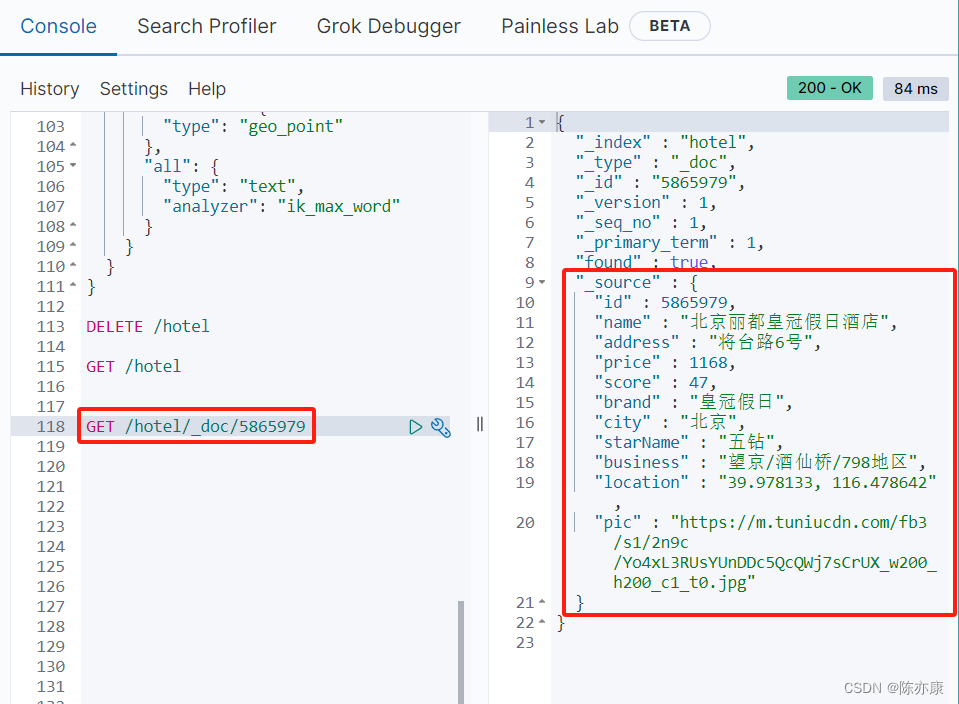
1.3.3、根据 id 查询酒店数据
这里值得注意的是:通过 client.get 查询到的是一个 GetResponse 对象,需要获取里面的原数据.
代码如下:
@Test
public void testGetDocument() throws IOException {
//1.构造请求
GetRequest request = new GetRequest("hotel").id("5865979");
//2.发送请求
GetResponse response = client.get(request, RequestOptions.DEFAULT);
//3.转化成json
String json = response.getSourceAsString();
System.out.println(json);
}
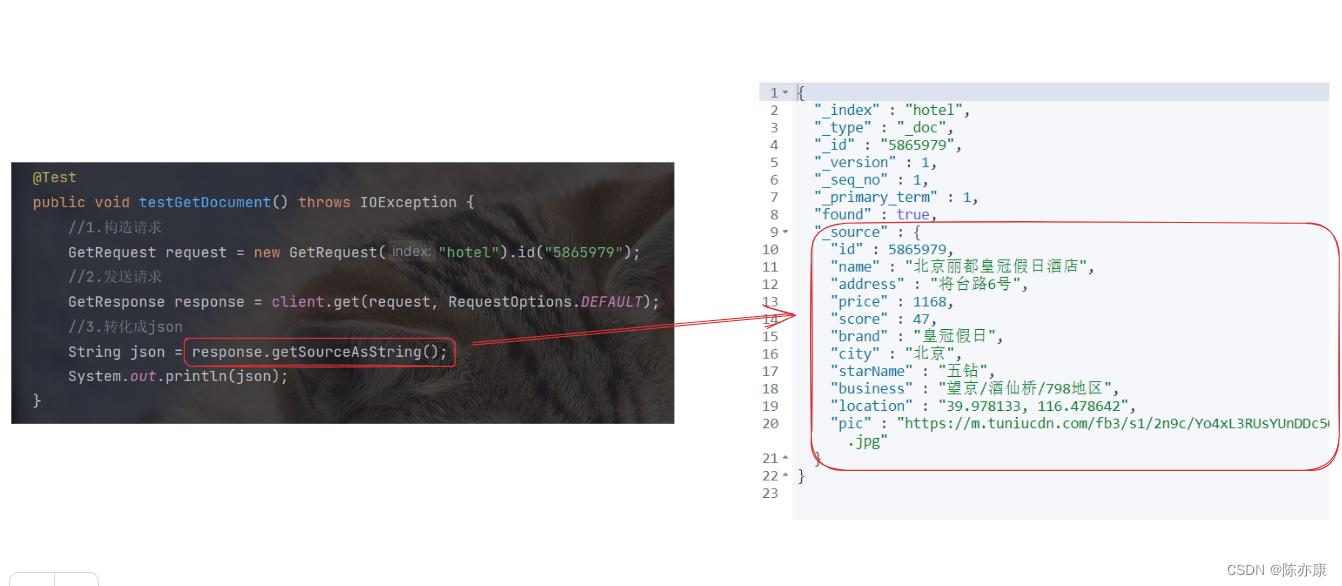
运行后就可以得到对应的数据

1.3.4、根据 id 修改酒店数据
修改文档数据有两种方式(之前提到过):
- 全量更新(就是上面演示的添加文档):再次写入 id 一样的文档,就会删除旧文档,添加新文档.
- 局部更新(演示这个):只更新部分字段.
@Test
public void testUpdateDocument() throws IOException {
//1.构造请求
UpdateRequest request = new UpdateRequest("hotel", "5865979");
//2.填写参数
request.doc(
"name", "地表最强酒店",
"price", "99999"
);
//3.发送请求
client.update(request, RequestOptions.DEFAULT);
}
注意:request.doc 的参数中不可以直接传递对象,可以将对象先转化为 JSON 格式,然后在 doc 参数中通过 XContentType 指定 JSON 类型即可,如下
public void updateByArticleId(Long articleId) {
//1.创建修改请求
UpdateRequest request = new UpdateRequest(ESConstants.INDEX_ARTICLE, articleId.toString());
//2.填写修改参数
//1) 远程调用获取修改后的文章信息
ArticleESVO articleESVO = getESVOByArticleId(articleId);
String result = objectMapper.writeValueAsString(articleESVO);
//2) 修改文档
request.doc(result, XContentType.JSON);
//2.发送修改请求
client.update(request, RequestOptions.DEFAULT);
}
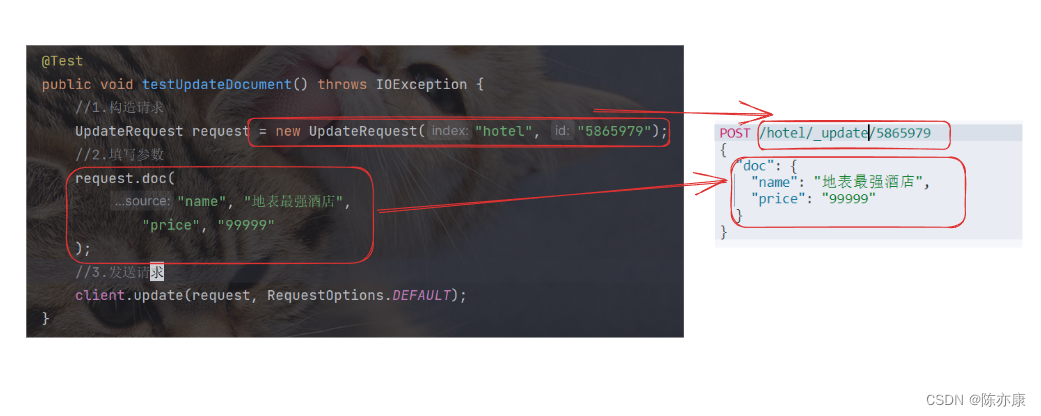
在 Kibana 上通过 GET 查询如下:
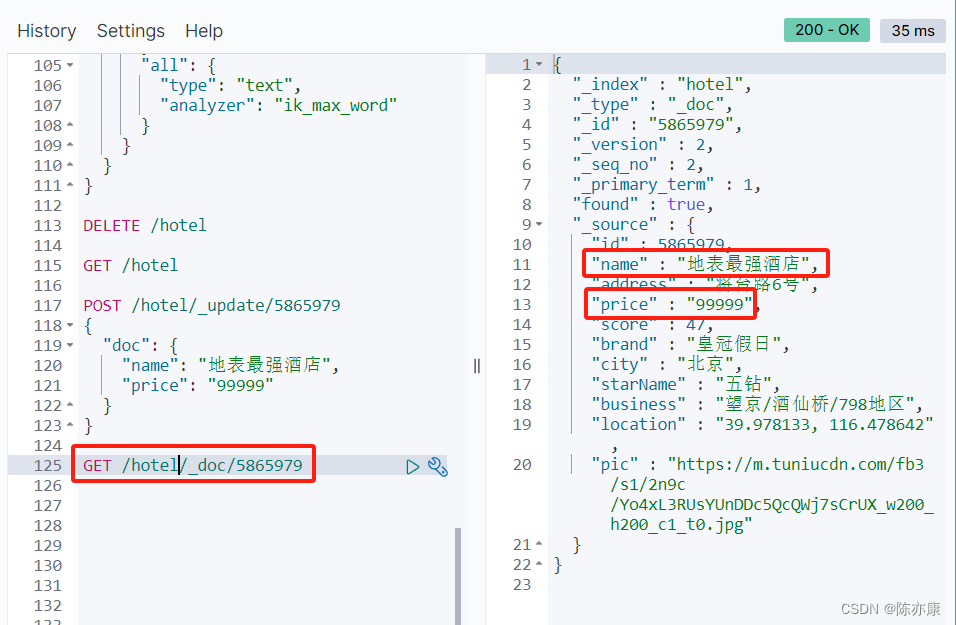
1.3.5、根据 id 删除文档数据
删除文档代码如下:
@Test
public void testDeleteDocument() throws IOException {
//1.构造请求
DeleteRequest request = new DeleteRequest("hotel", "5865979");
//2.发送请求
client.delete(request, RequestOptions.DEFAULT);
}
1.3.6、批量导入文档
例如导入酒店的所有数据,代码如下:
@Test
public void testBulkDocument() throws IOException {
//1.获取酒店所有数据
List<Hotel> hotelList = hotelService.list();
//2.构造请求
BulkRequest request = new BulkRequest();
//3.准备参数
for(Hotel hotel : hotelList) {
//转化为文档(主要是地理位置)
HotelDoc hotelDoc = new HotelDoc(hotel);
String json = objectMapper.writeValueAsString(hotelDoc);
request.add(new IndexRequest("hotel").id(hotel.getId().toString()).source(json, XContentType.JSON));
}
//4.发送请求
client.bulk(request, RequestOptions.DEFAULT);
}
运行后可以看到通过了

之后再 Kibana 上随机查询一个酒店数据都是存在的


